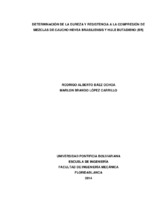Determinación de la dureza y resistencia a la comprensión de mezclas de caucho Hevea Brasiliensis y Hule Butadieno (BR)

View/
Date
2014-03xmlui.dri2xhtml.METS-1.0.item-advisor
Director. Santos Jaimes, Alfonso
xmlui.dri2xhtml.METS-1.0.item-type
Trabajo de grado
Citación
Metadata
Show full item recordDocuments PDF
Abstract
En este proyecto de grado se tiene como objetivo principal caracterizar mecánicamente la mezcla de caucho hevea brasiliensis y hule butadieno, a través de ensayos de Dureza y Resistencia a la compresión, para determinar la correlación de estas propiedades con el porcentaje de cada uno de los cauchos presentes en la mezcla. Durante el desarrollo del presente proyecto se realizó el diseño de una máquina vulcanizadora de caucho funcional teniendo como base los datos de presión (88,0856 KPa) y temperatura (165 °C) obtenidos a través de la experiencia de la industria. Luego se fabricaron 10 probetas con diferentes porcentajes de mezcla de caucho natural y hule Butadieno (BR), se realizaron aproximadamente 250 ensayos de dureza Shore y 10 pruebas de resistencia a la compresión a la totalidad de probetas, para luego organizar los resultados en tablas y gráficos que permitieran realizar el correcto análisis de los resultados obtenidos. Para los datos obtenidos en la práctica se manejó un coeficiente de correlacion igual o superior a 0.90 (R2 = 0.90), mediante el uso Excel se obtuvo como resultado un valor de dureza shore máximo promedio de 72.56, este valor fue obtenido en la probeta fabricada con 90% de hule butadieno y 10% de caucho natural; y un valor de dureza mínimo promedio de 66.82, que se obtuvo en la probeta compuesta 10% de hule butadieno y 90% de caucho natural. El mayor valor de resistencia a la compresión obtenido fue 509.29 KPa y se obtuvo en la probeta fabricada con 10% de hule butadieno y 90% de caucho natural, y el menor valor corresponde a 79.22 KPa encontrado en la probeta fabricada 90% de hule butadieno y 10% de caucho natural. The main objective of this graduate project is to mechanically characterize the blend of Hevea brasiliensis rubber and butadiene rubber, through Hardness and compressive strength testing to stablish the correlation between these properties and the percentage of each of the rubbers present in the mixture. In the development of this project, the analysis and design of a functional rubber vulcanizer machine based on pressure (88.0856 kPa) and temperature (165 ° C) data obtained through experience in the industry was performed. 10 specimens with different mixing ratios of natural rubber and butadiene rubber (BR) were produced, approximately 250 test and 10 Shore hardness testing compressive strength were conducted and then the data was organized in tables, and graphs done to allow proper analysis of the results. For the data obtained in practice, a determination coefficient equal to or greater than 0.90 (R2 = 0.90) was used. Through Excel the maximum Shore hardness was obtained resulting in an average value of 72.56, this value was obtained on the specimen made with 90% butadiene rubber and 10% natural rubber, and an average value of minimum hardness of 66.82, which was obtained in the test tube comprised 10% butadiene rubber and 90% natural rubber. The highest value of compressive strength obtained was 509.29 kPa and was obtained in the specimen made with 10% butadiene rubber and 90% natural rubber, and the smallest value corresponds to 79.22 KPa manufactured specimen found 90% of butadiene rubber and 10% natural rubber.
Keyword/s
Ingeniería Mecánica
Caucho
Mezcladoras
Compactación
Máquinas para caucho
Vulcanización
Collections
- Trabajos de grado [6698]
The following license files are associated with this item:

